A few noteworthy Constellations...(including the zodiac constellations)
Andromeda
In Greek mythology Andromeda was the daughter of King Cepheus and Queen Cassiopeia (both of whose constellations lie directly to the north of her). After Cassiopeia had boasted of being more beautiful than the sea nymphs, the sea god Neptune flooded the land and also sent a monster to ravage it. To placate the sea god, Andromeda was chained to a rock and was about to be devoured by the monster when she was rescued at the last moment by Perseus (another constellation to the east) whom she later married.
In Greek mythology Andromeda was the daughter of King Cepheus and Queen Cassiopeia (both of whose constellations lie directly to the north of her). After Cassiopeia had boasted of being more beautiful than the sea nymphs, the sea god Neptune flooded the land and also sent a monster to ravage it. To placate the sea god, Andromeda was chained to a rock and was about to be devoured by the monster when she was rescued at the last moment by Perseus (another constellation to the east) whom she later married.
Features of interest: Andromeda Galaxy M31 and its companions M32 and M110; Open Star Cluster NGC 752; Blue Snowball planetary nebula NGC 7662 and Triangulum Galaxy M33.

A large constellation in the zodiac between Capricorn and Pisces and in Greek mythology represents the "water bearer" Ganymede whom Zeus whisked off to Mount Olympus to be his cup bearer and a waiter to the gods. The stars Gamma Aquarii, Zeta Aquarii, Eta Aquarii and Pi Aquarii, make up the water jar from which a stream of water flows south towards Pisces Austrinus.
Features of interest: Globular Cluster M2; Saturn Nebula NGC 7009; Helix Nebula NGC 7293.
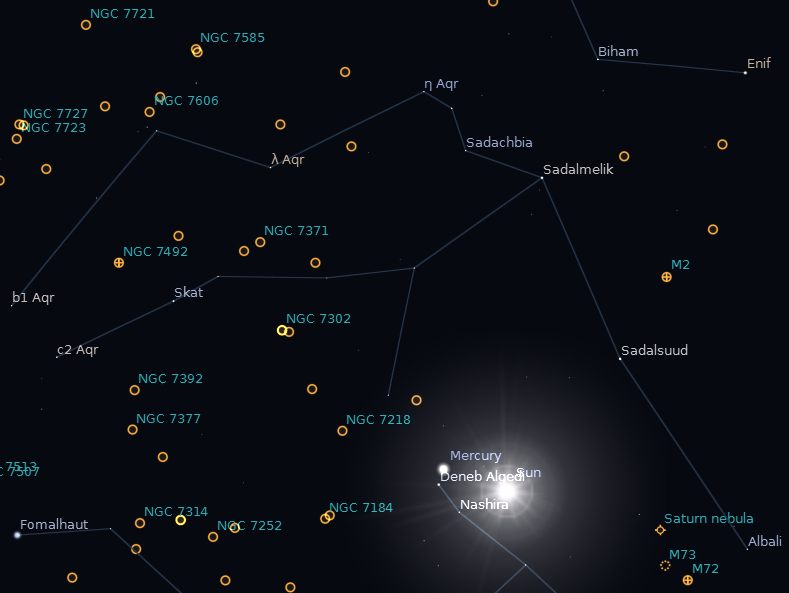
This constellation in Greek mythology depicts the servant eagle of the god Zeus which carried the thunderbolts that Zeus would hurl at his enemies. One legend says Zeus either sent the eagle, or turned himself into an eagle, to carry the shepherd boy Ganymede (Aquarius) up to Mount Olympus where he would serve as waterboy and waiter to the gods. It lies in a rich area of the Milky Way with Cygnus to the north and Scutum and Sagittarius to the south. It's brightest star, Altair forms part of the asterism known as the "Summer Trianlge", along with Deneb (in Cygnus) and Vega (in Lyra).
Features of interest: Open Cluster NGC 6709; Open Cluster NGC 6755.
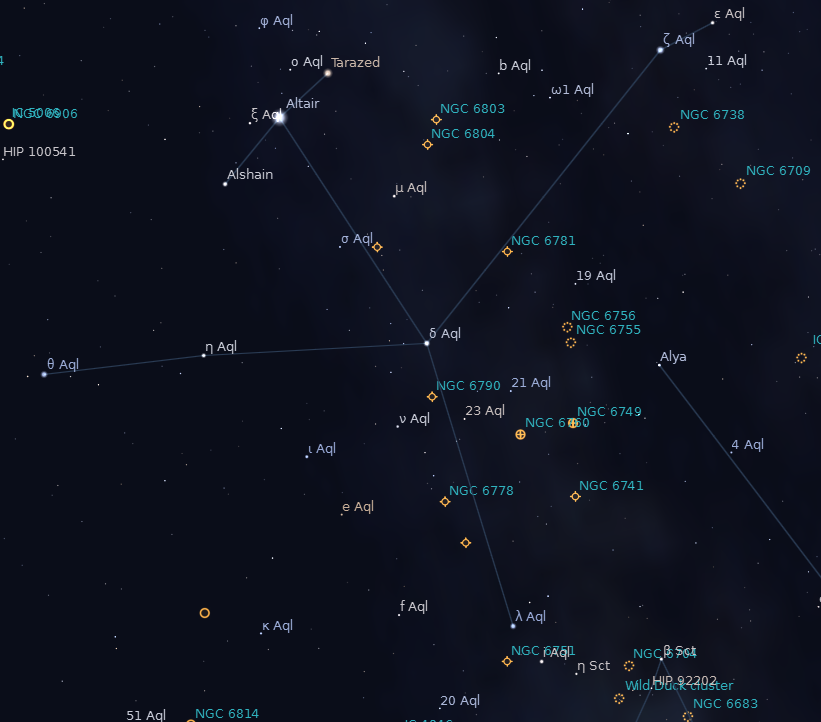
In Greek mythology, Aries was the ram whose Golden Fleece was hung out on the eastern shore of the Black Sea. Jason and the Argonauts (in the great Ship The Argo Narvis) undertook an epic voyage to bring this fleece back to Greece. Aries also represents the flying ram that was sent by the god Hermes (Mercury) to rescue the royal siblings Helle and Phryxus from their murderous stepmother Ino.
It's most recognisable feature is a crooked line of three stars; Alpha Arietis (Hamal), Beta Arietis (Sheratan) & Gamma Arietis (Mesarthim).
Features of interest: Mesarthim, a double star whose components are actually both very similar blue-white stars.
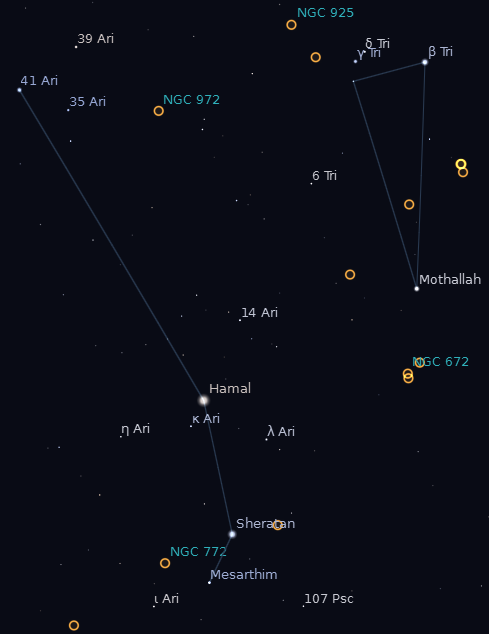
In Greek mythology Auriga represents a charioteer, usually understood to be Ericthonius, the legendary King of Athens. It lies along the Milky Way band of stars between Gemini and Perseus, and north of Orion.
Features of interest: The Pinwheel Cluster M36; Auriga Salt and Pepper M37 and M38.
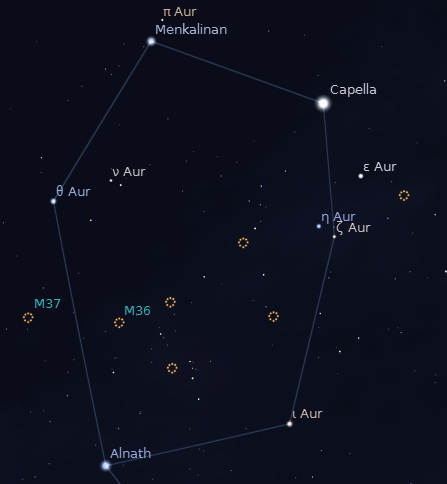
Features of interest: The Pinwheel Cluster M36; Auriga Salt and Pepper M37 and M38.

The faintest of the zodical constellations, Cancer lies between Gemini and Leo. In Greek mythology, it represents the crab that was sent by Hera (Juno) to harass Hercules while he battled with the multi-headed monster, the Hydra. Hercules took a few minutes to crush the crab and then proceeded to finish off the monster. Historically, Cancer is known for being the constellation that the Sun is in at the summer solstice, and today the highest latitude that the Sun reaches at noon on solstice day is still known as the Tropic of Cancer, even though the Sun's highest latitude attained during the summer solstice now actually occurs in the constellation of Gemini.
Features of interest: Beehive Cluster M44 (aka the Praesepe Cluster); NGC 2862 (M67).
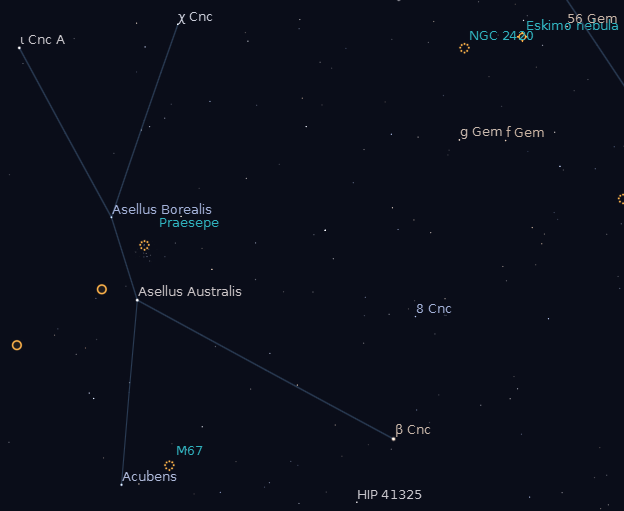
The "Big Dog", one of the hunting dogs associated with the great hunter Orion - the other being Canis Minor, the "Little Dog". This constellation is famous as home to the brightest star in the night sky, Sirius, which is one of the three stars (along with Procyon in Canis Minor, and Betelgeuse in Orion) that make up the famous asterism know as the "Winter Triangle".
Features of interest: Mexican Jumping Star (actually a cluster, NGC 2362); Open Cluster M41.
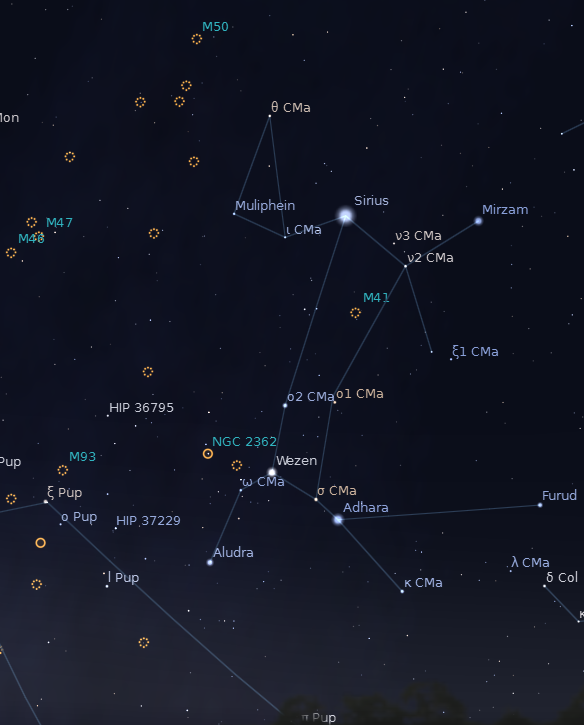
The smallest of the 12 zodiac constellations, Capricorn (Latin for "horned goat") lies in the southern sky between Sagittarius and Aquarius. In Greek mythology, it is associated with the goat-like god Pan, who is said to have jumped into a river and turned himself into a creature half-goat and half-fish in a desperate bid to escape the sea monster Typhon. About 2500 years ago the sun used to be in this constellation during the winter solstice, but due to the Earth's precessional motion the winter solstice now occurs with the Sun in Sagittarius, however the latitude of the Sun at it's southern most in the sky at winter solstice is still known today as the Tropic of Capricorn.
Features of interest: Globular Cluster M30 (NGC 2362).
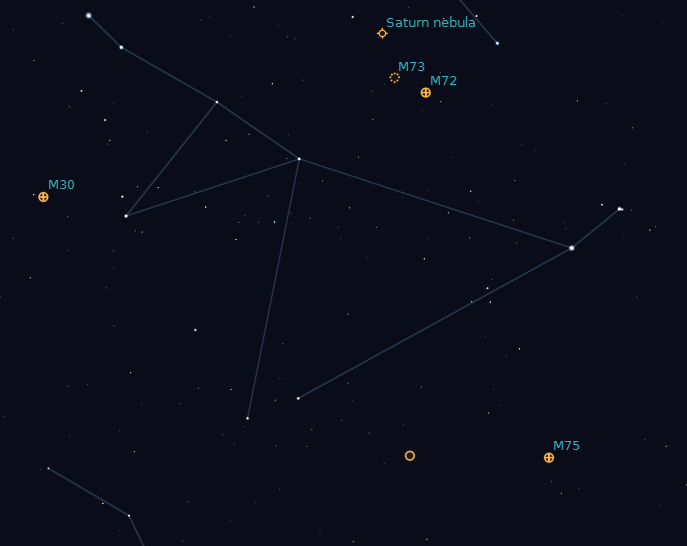
This constellation lies in a prominent band of the Milky Way between Perseus and Cepheus and in Greek mythology is named after the infamously vain Greek (Ethiopian?) Queen who was married to King Cepheus and whose boast of her own personal beauty nearly cost her daughter Andromeda to be consumed by a maurauding sea monster sent by Neptune. It's five main stars form an easily recognisable 'W' shape, and the Queen is usually depicted as hanging upside down, as punishment for her vanity.
Features of interest: Cassiopeia Salt-And-Pepper Cluster M52; M103 Cluster ; Pac Man Nebula.
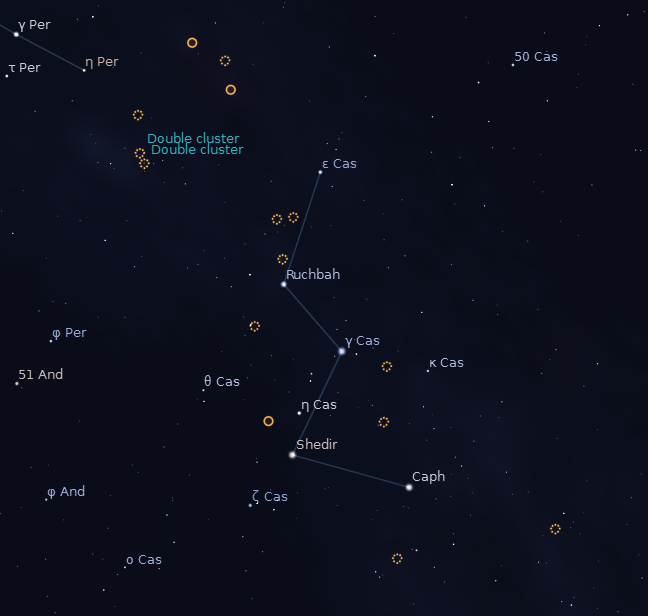
In Greek mythology Centaurus is regarded as the centaur Chiron (a creature with the body of a horse and head chest and arms of a man). Chiron taught many Greek heroes including Jason (of the Argonauts) and Hercules, who accidentally shot Chiron with a poisoned arrow, and although Chiron was immortal, he was given permission to die by the god Zeus, thereby relieving him of the potentially everlasting pain from the poisoned arrow. Centaurus is famous for being home to the closest star to our Sun, Proxima Centauri, the third member of a Multiple Star System that includes the Alpha Centauri binaries (Rigel Kentaurus A and Rigel Kentaurus B). The chart graphic below also shows the southern constellations of Crux and Musca, which just so happen to be in very close proximity.
Features of interest: Globular Cluster Omega Centauri (NGC 5139); Centaurus A galaxy (NGC 5128); Blue Planetary Nebula (NGC 3918).
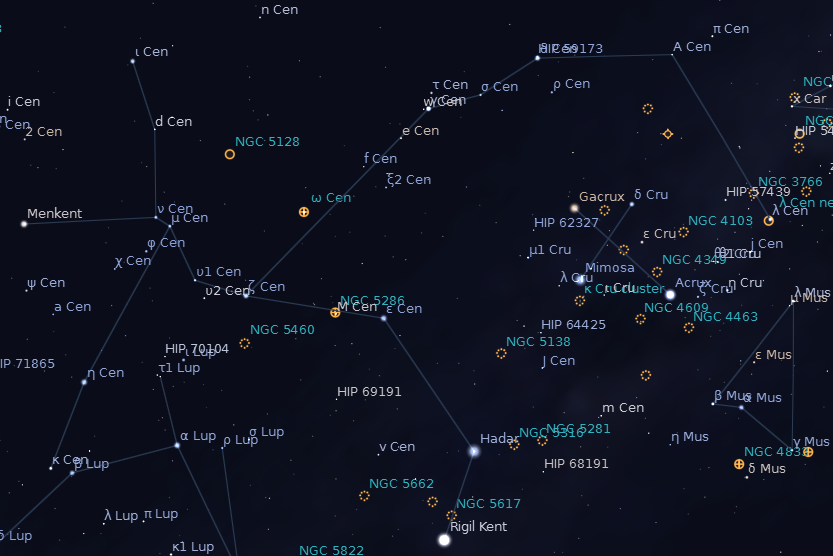
Features of interest: Yellow Supergiant Delta Cephei; Garnet Star Mu Cehpei in cluster IC1396.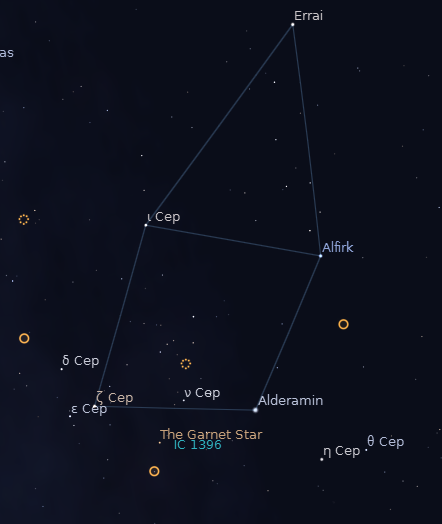
Features of interest: Omicron (o) Ceti (Mira); Seyfert spiral galaxy M77.
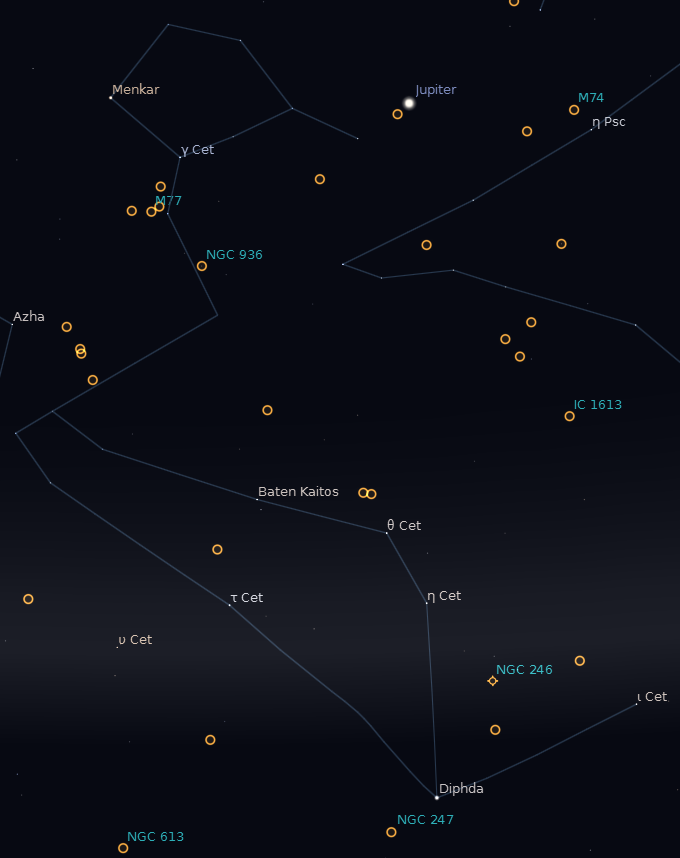
Features of interest: Open Cluster M35; The Eskimo Nebula NGC 2392 (aka Clown Face Nebula); NGC 2129;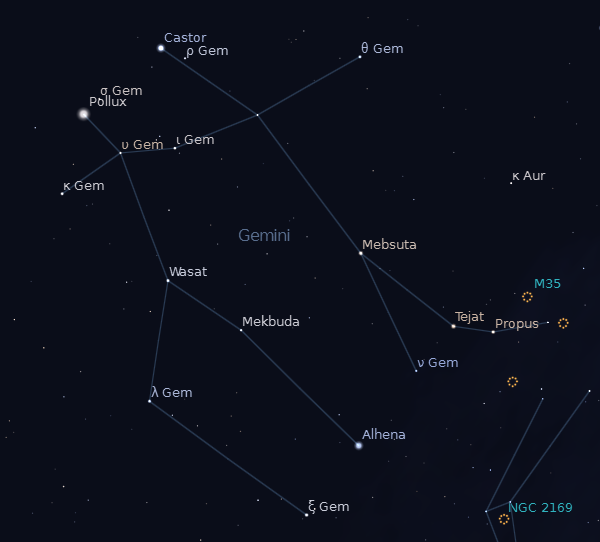
Features of interest: Spiral Galaxies M65 and M66; fainter Spiral Galaxies M95 and M96.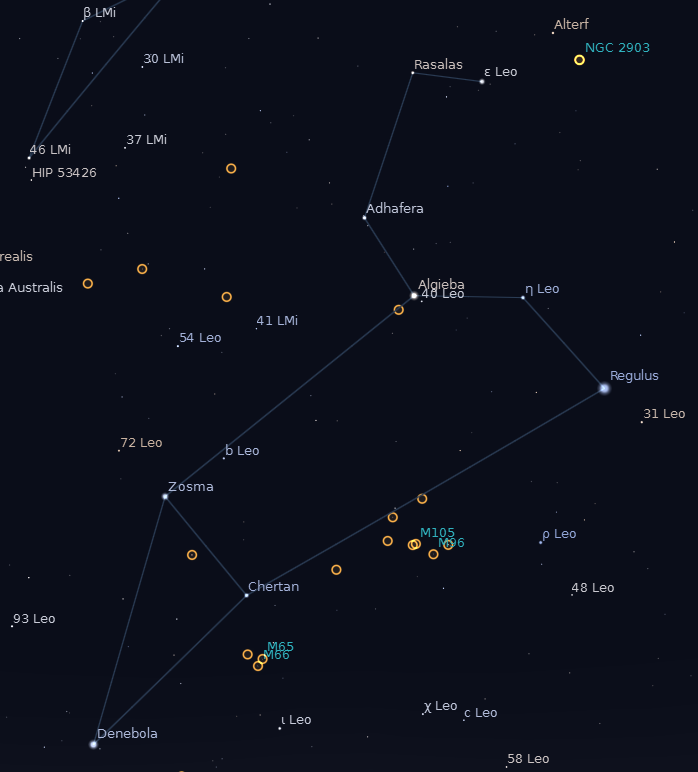
Features of interest: Globular Cluster M79 (aka NGC 1904); NGC 2017.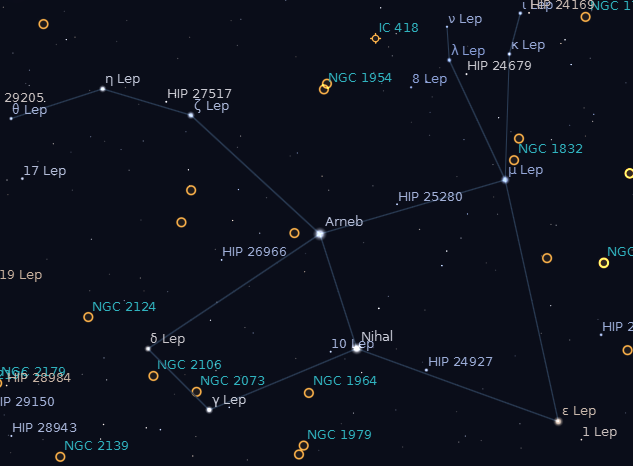
Libra
A constellation of the zodiac between Virgo and Scorpio, Libra represents the scales of justice held by Virgo - both the Egyptians and Romans (who added it to the constellations that make up the zodiac) saw this constellation as scales. The ancient Greeks however, visualized the constellation as the claws of the neighbouring scorpion, as a result, its two brightest stars still retain names that translate as "northern claw" and "southern claw". Features of interest: faint Globular Cluster NGC 5897;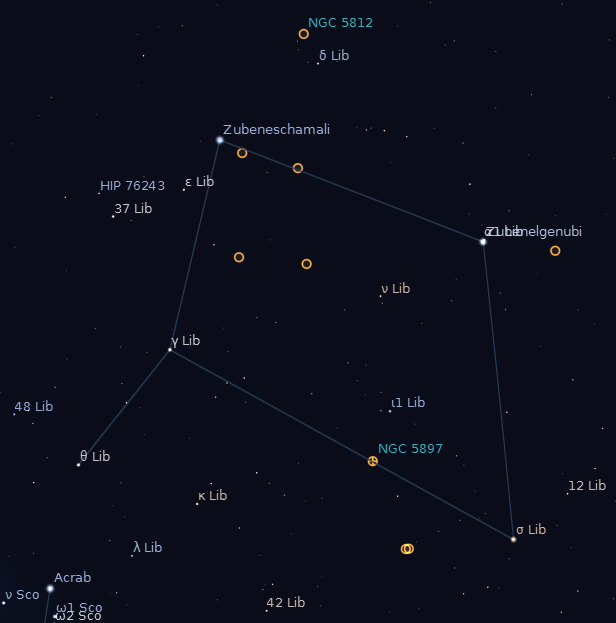
Features of interest: Open Cluster NGC 5822.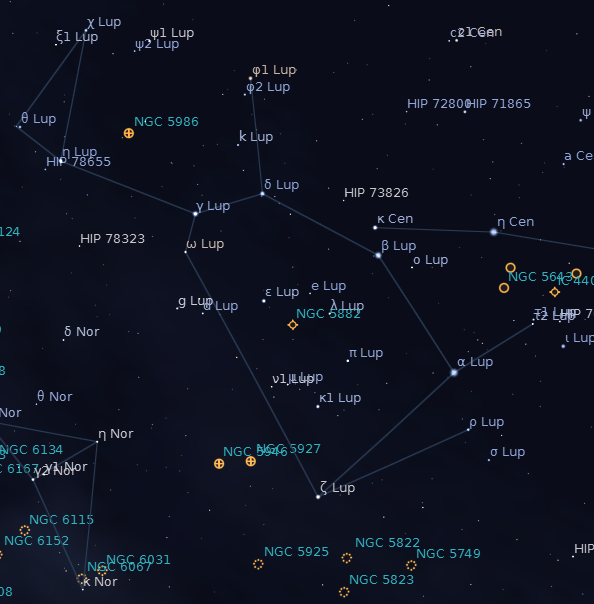
Features of interest: Orion Nebulae M42 and M43; Trapezium - four star system; Betelgeuse - one of the biggest ever supergiants known; Horsehead Nebula (near IC 434); Nebula NGC 1977; Star Cluster NGC 1981.
Features of interest: Eclipsing binary star - Algol; Spiral Cluster M34; The Double Cluster NGC 869 and NGC 884 (aka the Sword-Handle);
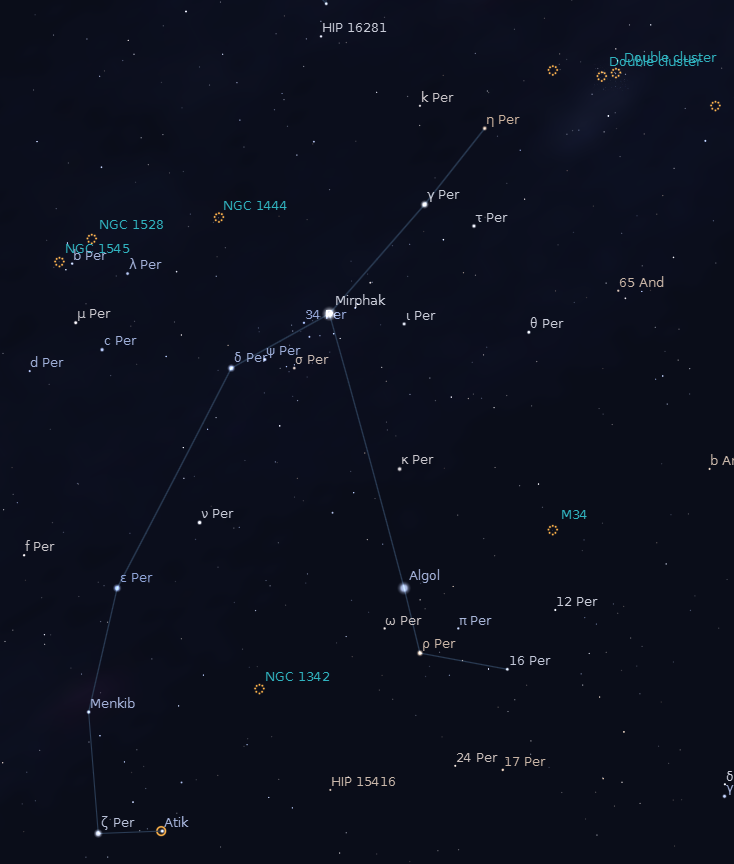
Features of interest: The Circlet Asterism; Spiral Galaxy M74.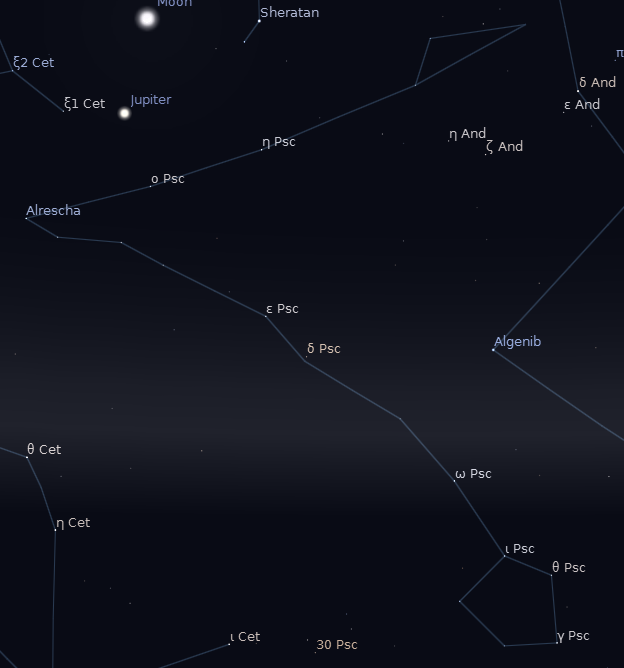
Sagittarius
"The Archer", represents the mythical beast that is half man and half horse, and is thought to be Crotus the offspring of the goat god Pan and the nymph Eupheme, nurse of the Muses (among whom he was raised). Crotus grew to be skilled in the arts as well as a great hunter, and at his death the Muses entreated Zeus to place him among the stars. The most recognisable feature of this constellation is the asterism known as the "Teapot". The handle of the teapot is also often referred to as the "Milk Dipper", imagined to be scooping into the Milky Way. The exact centre of our Milky Way Galaxy is thought coincide with a strong radio source known as Sagittarius A, which lies just south of the spout of the teapot asterism, where there is believed to be a Black Hole.
Features of interest: Lagoon Nebula M8; Trifid Nebula M20; Omega Nebula M17 (aka Horseshoe Nebula); Open Cluster M25 (IC 4725); Open Cluster M23; Globular Cluster M22 (NGC 6626); Star Field M24;
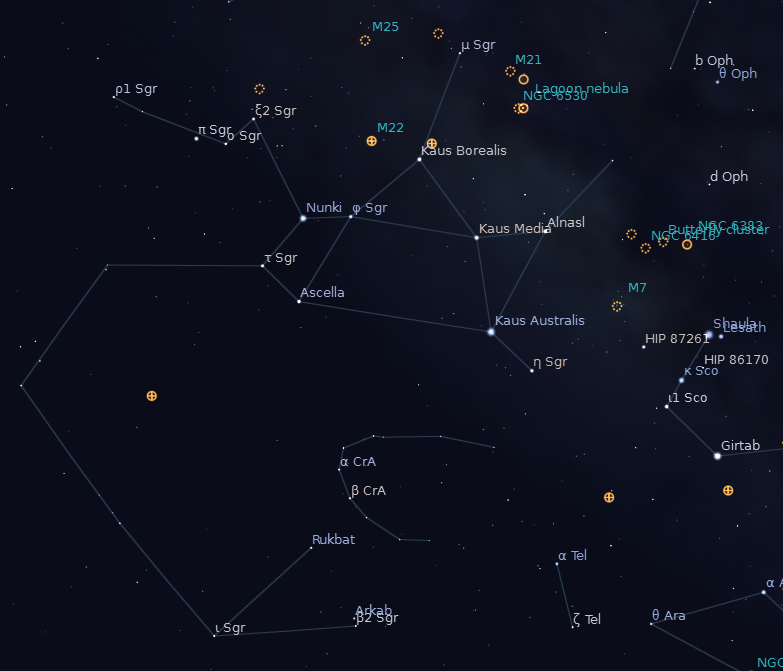
Features of interest: Butterfly Cluster M6; Ptolemy's Cluster M7; Globular Cluster M4; Open Cluster NGC 6383;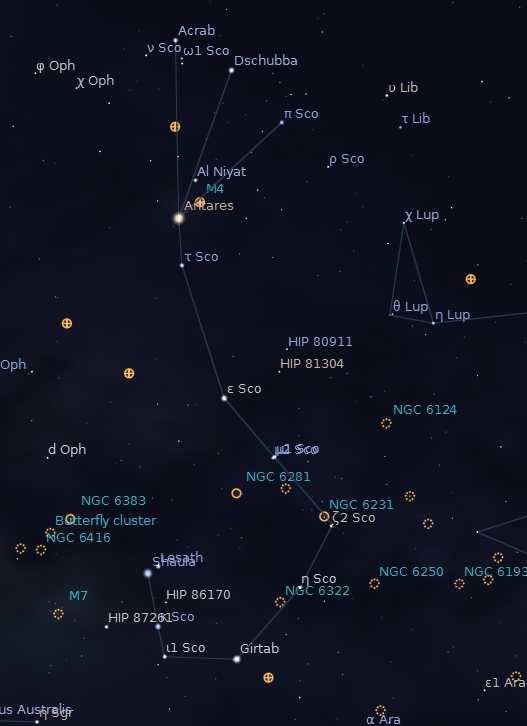
Features of interest: Hyades Star Cluster; Pleiades Star Cluster; Crab Nebula M1; Eclipsing Binary Lamba (?) Tauri.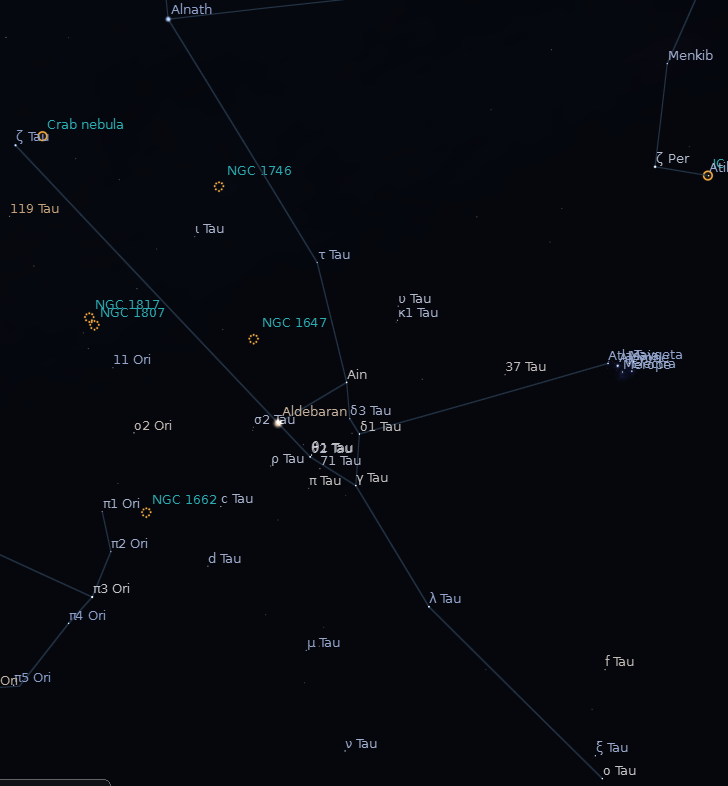
Ursa Major"The Big Bear" is a large and prominent constellation of the northern sky which is usually visible all year from mid to northern latitudes. Seven of its stars form the familiar asterism known as "The Plough" or "Big Dipper", but this asterism only makes up a part of the whole constellation. The two stars Merak and Dubhe in the part of the bowl furthest from the handle act as pointers to the North Pole star Polaris. In Greek mythology, Ursa represents Zeus's lover, Hera, who was turned into a bear by his wife Hera in a fit of jealousy. In another legend, Usra is said to represent Adrasteia, one of the two nymphs who nursed an infant Zeus, hiding him from his murderous father, Cronus. The other nymph is represented by Ursa Minor, "The Little Bear", whose tail tip marks Polaris.Features of interest: Bodes Galaxy M81; Irregular Galaxy M82 (companion to M81); Pinwheel Galaxy M101; The Owl Nebula M97; Spiral Galaxy M109.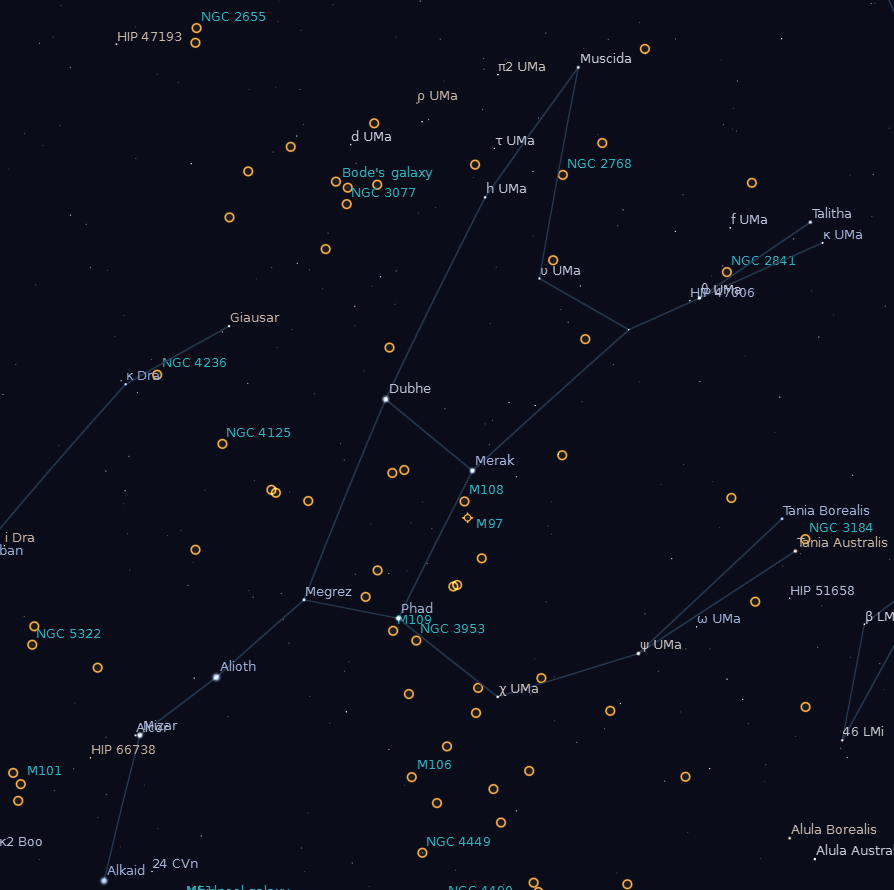
VirgoThe largest of the zodiac constellations, and the second largest overall, Virgo the virgin is usually associated with Demeter, Greek goddess of the harvest, reinforced by the fact that the figure is often portrayed holding wheat, and also the brightest star Spica means "ear of wheat". Virgo is also linked to Astraea, the goddess of justice, (and thereby associated with the constellation of Libra, "the scales of justice"). The sun enters the constellation of Virgo at the time of the September equinox every year, and spends at least six weeks in this constellation - the longest of any of the zodiac constellations.Features of interest: Sombrero Galaxy M104; Smoking Gun Galaxy M87; Virgo Cluster of Galaxies M49, M60, M84, M86 M87.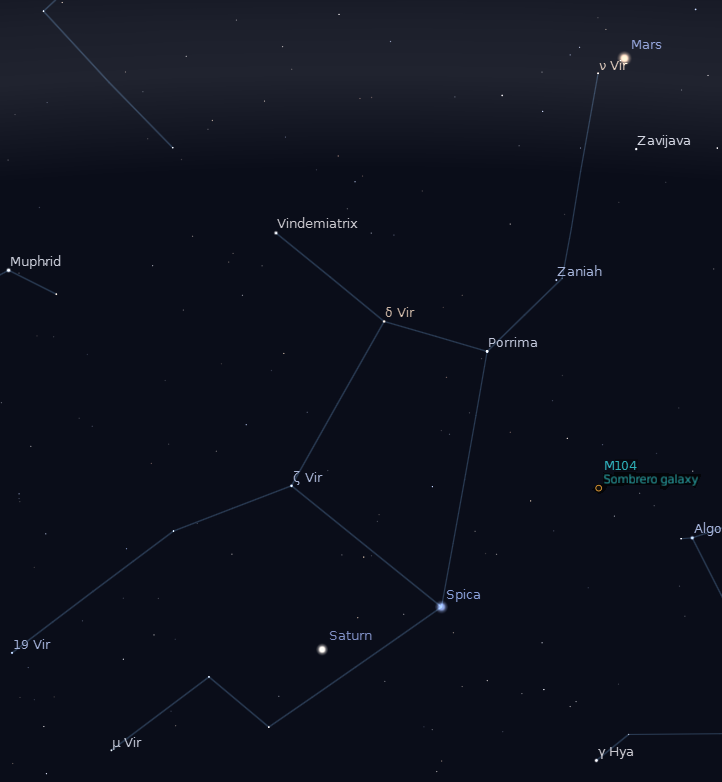
Charts created using a very recent version of Stellarium - v 0.11.1
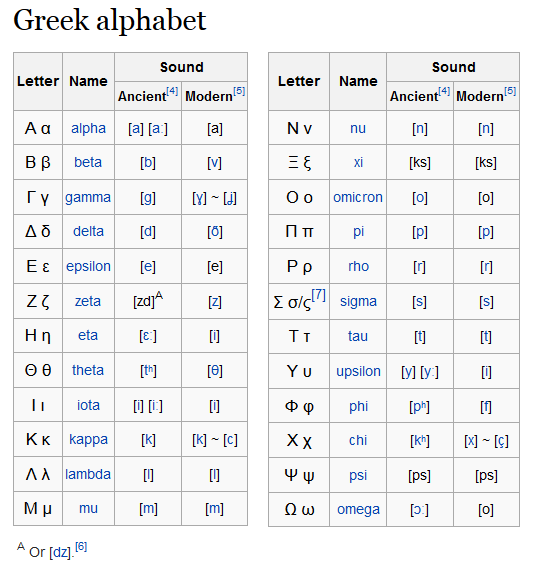
Greek alphabet
(Α α: alpha),
(Β β: beta),
(Γ γ: gamma),
(Δ δ: delta),
(Ε ε: epsilon),
(Ζ ζ: zeta),
(Η η: eta),
(Θ θ: theta),
(Ι ι: iota),
(Κ κ: kappa),
(Λ λ: lambda),
(Μ μ: mu),
(Ν ν: nu),
(Ξ ξ: xi),
(Ο ο: omicron),
(Π π: pi),
(Ρ ρ: rho),
(Σ σ/ς: sigma),
(Τ τ: tau),
(Υ υ: upsilon),
(Φ φ: phi),
(Χ χ: chi),
(Ψ ψ: psi),
(Ω ω: omega).
Features of interest: Yellow Supergiant Delta Cephei; Garnet Star Mu Cehpei in cluster IC1396.

Features of interest: Omicron (o) Ceti (Mira); Seyfert spiral galaxy M77.

Features of interest: Open Cluster M35; The Eskimo Nebula NGC 2392 (aka Clown Face Nebula); NGC 2129;
Features of interest: Spiral Galaxies M65 and M66; fainter Spiral Galaxies M95 and M96.
Features of interest: Globular Cluster M79 (aka NGC 1904); NGC 2017.
Libra
A constellation of the zodiac between Virgo and Scorpio, Libra represents the scales of justice held by Virgo - both the Egyptians and Romans (who added it to the constellations that make up the zodiac) saw this constellation as scales. The ancient Greeks however, visualized the constellation as the claws of the neighbouring scorpion, as a result, its two brightest stars still retain names that translate as "northern claw" and "southern claw". Features of interest: faint Globular Cluster NGC 5897;
Features of interest: Open Cluster NGC 5822.
Features of interest: Orion Nebulae M42 and M43; Trapezium - four star system; Betelgeuse - one of the biggest ever supergiants known; Horsehead Nebula (near IC 434); Nebula NGC 1977; Star Cluster NGC 1981.
Features of interest: Eclipsing binary star - Algol; Spiral Cluster M34; The Double Cluster NGC 869 and NGC 884 (aka the Sword-Handle);

Features of interest: The Circlet Asterism; Spiral Galaxy M74.
Sagittarius
"The Archer", represents the mythical beast that is half man and half horse, and is thought to be Crotus the offspring of the goat god Pan and the nymph Eupheme, nurse of the Muses (among whom he was raised). Crotus grew to be skilled in the arts as well as a great hunter, and at his death the Muses entreated Zeus to place him among the stars. The most recognisable feature of this constellation is the asterism known as the "Teapot". The handle of the teapot is also often referred to as the "Milk Dipper", imagined to be scooping into the Milky Way. The exact centre of our Milky Way Galaxy is thought coincide with a strong radio source known as Sagittarius A, which lies just south of the spout of the teapot asterism, where there is believed to be a Black Hole.
Features of interest: Lagoon Nebula M8; Trifid Nebula M20; Omega Nebula M17 (aka Horseshoe Nebula); Open Cluster M25 (IC 4725); Open Cluster M23; Globular Cluster M22 (NGC 6626); Star Field M24;

Features of interest: Butterfly Cluster M6; Ptolemy's Cluster M7; Globular Cluster M4; Open Cluster NGC 6383;
Features of interest: Hyades Star Cluster; Pleiades Star Cluster; Crab Nebula M1; Eclipsing Binary Lamba (?) Tauri.
Ursa Major"The Big Bear" is a large and prominent constellation of the northern sky which is usually visible all year from mid to northern latitudes. Seven of its stars form the familiar asterism known as "The Plough" or "Big Dipper", but this asterism only makes up a part of the whole constellation. The two stars Merak and Dubhe in the part of the bowl furthest from the handle act as pointers to the North Pole star Polaris. In Greek mythology, Ursa represents Zeus's lover, Hera, who was turned into a bear by his wife Hera in a fit of jealousy. In another legend, Usra is said to represent Adrasteia, one of the two nymphs who nursed an infant Zeus, hiding him from his murderous father, Cronus. The other nymph is represented by Ursa Minor, "The Little Bear", whose tail tip marks Polaris.Features of interest: Bodes Galaxy M81; Irregular Galaxy M82 (companion to M81); Pinwheel Galaxy M101; The Owl Nebula M97; Spiral Galaxy M109.
VirgoThe largest of the zodiac constellations, and the second largest overall, Virgo the virgin is usually associated with Demeter, Greek goddess of the harvest, reinforced by the fact that the figure is often portrayed holding wheat, and also the brightest star Spica means "ear of wheat". Virgo is also linked to Astraea, the goddess of justice, (and thereby associated with the constellation of Libra, "the scales of justice"). The sun enters the constellation of Virgo at the time of the September equinox every year, and spends at least six weeks in this constellation - the longest of any of the zodiac constellations.Features of interest: Sombrero Galaxy M104; Smoking Gun Galaxy M87; Virgo Cluster of Galaxies M49, M60, M84, M86 M87.
Charts created using a very recent version of Stellarium - v 0.11.1

Features of interest: Open Cluster M35; The Eskimo Nebula NGC 2392 (aka Clown Face Nebula); NGC 2129;
Features of interest: Spiral Galaxies M65 and M66; fainter Spiral Galaxies M95 and M96.
Features of interest: Globular Cluster M79 (aka NGC 1904); NGC 2017.
Libra
A constellation of the zodiac between Virgo and Scorpio, Libra represents the scales of justice held by Virgo - both the Egyptians and Romans (who added it to the constellations that make up the zodiac) saw this constellation as scales. The ancient Greeks however, visualized the constellation as the claws of the neighbouring scorpion, as a result, its two brightest stars still retain names that translate as "northern claw" and "southern claw". Features of interest: faint Globular Cluster NGC 5897;
Features of interest: Open Cluster NGC 5822.
Features of interest: Orion Nebulae M42 and M43; Trapezium - four star system; Betelgeuse - one of the biggest ever supergiants known; Horsehead Nebula (near IC 434); Nebula NGC 1977; Star Cluster NGC 1981.
Features of interest: Eclipsing binary star - Algol; Spiral Cluster M34; The Double Cluster NGC 869 and NGC 884 (aka the Sword-Handle);

Features of interest: The Circlet Asterism; Spiral Galaxy M74.
Sagittarius
"The Archer", represents the mythical beast that is half man and half horse, and is thought to be Crotus the offspring of the goat god Pan and the nymph Eupheme, nurse of the Muses (among whom he was raised). Crotus grew to be skilled in the arts as well as a great hunter, and at his death the Muses entreated Zeus to place him among the stars. The most recognisable feature of this constellation is the asterism known as the "Teapot". The handle of the teapot is also often referred to as the "Milk Dipper", imagined to be scooping into the Milky Way. The exact centre of our Milky Way Galaxy is thought coincide with a strong radio source known as Sagittarius A, which lies just south of the spout of the teapot asterism, where there is believed to be a Black Hole.
Features of interest: Lagoon Nebula M8; Trifid Nebula M20; Omega Nebula M17 (aka Horseshoe Nebula); Open Cluster M25 (IC 4725); Open Cluster M23; Globular Cluster M22 (NGC 6626); Star Field M24;

Features of interest: Butterfly Cluster M6; Ptolemy's Cluster M7; Globular Cluster M4; Open Cluster NGC 6383;
Features of interest: Hyades Star Cluster; Pleiades Star Cluster; Crab Nebula M1; Eclipsing Binary Lamba (?) Tauri.
Ursa Major"The Big Bear" is a large and prominent constellation of the northern sky which is usually visible all year from mid to northern latitudes. Seven of its stars form the familiar asterism known as "The Plough" or "Big Dipper", but this asterism only makes up a part of the whole constellation. The two stars Merak and Dubhe in the part of the bowl furthest from the handle act as pointers to the North Pole star Polaris. In Greek mythology, Ursa represents Zeus's lover, Hera, who was turned into a bear by his wife Hera in a fit of jealousy. In another legend, Usra is said to represent Adrasteia, one of the two nymphs who nursed an infant Zeus, hiding him from his murderous father, Cronus. The other nymph is represented by Ursa Minor, "The Little Bear", whose tail tip marks Polaris.Features of interest: Bodes Galaxy M81; Irregular Galaxy M82 (companion to M81); Pinwheel Galaxy M101; The Owl Nebula M97; Spiral Galaxy M109.
VirgoThe largest of the zodiac constellations, and the second largest overall, Virgo the virgin is usually associated with Demeter, Greek goddess of the harvest, reinforced by the fact that the figure is often portrayed holding wheat, and also the brightest star Spica means "ear of wheat". Virgo is also linked to Astraea, the goddess of justice, (and thereby associated with the constellation of Libra, "the scales of justice"). The sun enters the constellation of Virgo at the time of the September equinox every year, and spends at least six weeks in this constellation - the longest of any of the zodiac constellations.Features of interest: Sombrero Galaxy M104; Smoking Gun Galaxy M87; Virgo Cluster of Galaxies M49, M60, M84, M86 M87.
Charts created using a very recent version of Stellarium - v 0.11.1
Features of interest: Open Cluster M35; The Eskimo Nebula NGC 2392 (aka Clown Face Nebula); NGC 2129;
Features of interest: Spiral Galaxies M65 and M66; fainter Spiral Galaxies M95 and M96.
Features of interest: Globular Cluster M79 (aka NGC 1904); NGC 2017.
Libra
A constellation of the zodiac between Virgo and Scorpio, Libra represents the scales of justice held by Virgo - both the Egyptians and Romans (who added it to the constellations that make up the zodiac) saw this constellation as scales. The ancient Greeks however, visualized the constellation as the claws of the neighbouring scorpion, as a result, its two brightest stars still retain names that translate as "northern claw" and "southern claw". Features of interest: faint Globular Cluster NGC 5897;
Features of interest: Open Cluster NGC 5822.
Features of interest: Orion Nebulae M42 and M43; Trapezium - four star system; Betelgeuse - one of the biggest ever supergiants known; Horsehead Nebula (near IC 434); Nebula NGC 1977; Star Cluster NGC 1981.
Features of interest: Eclipsing binary star - Algol; Spiral Cluster M34; The Double Cluster NGC 869 and NGC 884 (aka the Sword-Handle);

Features of interest: The Circlet Asterism; Spiral Galaxy M74.
Sagittarius
"The Archer", represents the mythical beast that is half man and half horse, and is thought to be Crotus the offspring of the goat god Pan and the nymph Eupheme, nurse of the Muses (among whom he was raised). Crotus grew to be skilled in the arts as well as a great hunter, and at his death the Muses entreated Zeus to place him among the stars. The most recognisable feature of this constellation is the asterism known as the "Teapot". The handle of the teapot is also often referred to as the "Milk Dipper", imagined to be scooping into the Milky Way. The exact centre of our Milky Way Galaxy is thought coincide with a strong radio source known as Sagittarius A, which lies just south of the spout of the teapot asterism, where there is believed to be a Black Hole.
Features of interest: Lagoon Nebula M8; Trifid Nebula M20; Omega Nebula M17 (aka Horseshoe Nebula); Open Cluster M25 (IC 4725); Open Cluster M23; Globular Cluster M22 (NGC 6626); Star Field M24;

Features of interest: Butterfly Cluster M6; Ptolemy's Cluster M7; Globular Cluster M4; Open Cluster NGC 6383;
Features of interest: Hyades Star Cluster; Pleiades Star Cluster; Crab Nebula M1; Eclipsing Binary Lamba (?) Tauri.
Ursa Major"The Big Bear" is a large and prominent constellation of the northern sky which is usually visible all year from mid to northern latitudes. Seven of its stars form the familiar asterism known as "The Plough" or "Big Dipper", but this asterism only makes up a part of the whole constellation. The two stars Merak and Dubhe in the part of the bowl furthest from the handle act as pointers to the North Pole star Polaris. In Greek mythology, Ursa represents Zeus's lover, Hera, who was turned into a bear by his wife Hera in a fit of jealousy. In another legend, Usra is said to represent Adrasteia, one of the two nymphs who nursed an infant Zeus, hiding him from his murderous father, Cronus. The other nymph is represented by Ursa Minor, "The Little Bear", whose tail tip marks Polaris.Features of interest: Bodes Galaxy M81; Irregular Galaxy M82 (companion to M81); Pinwheel Galaxy M101; The Owl Nebula M97; Spiral Galaxy M109.
VirgoThe largest of the zodiac constellations, and the second largest overall, Virgo the virgin is usually associated with Demeter, Greek goddess of the harvest, reinforced by the fact that the figure is often portrayed holding wheat, and also the brightest star Spica means "ear of wheat". Virgo is also linked to Astraea, the goddess of justice, (and thereby associated with the constellation of Libra, "the scales of justice"). The sun enters the constellation of Virgo at the time of the September equinox every year, and spends at least six weeks in this constellation - the longest of any of the zodiac constellations.Features of interest: Sombrero Galaxy M104; Smoking Gun Galaxy M87; Virgo Cluster of Galaxies M49, M60, M84, M86 M87.
Charts created using a very recent version of Stellarium - v 0.11.1

Features of interest: Spiral Galaxies M65 and M66; fainter Spiral Galaxies M95 and M96.
Features of interest: Globular Cluster M79 (aka NGC 1904); NGC 2017.
Libra
A constellation of the zodiac between Virgo and Scorpio, Libra represents the scales of justice held by Virgo - both the Egyptians and Romans (who added it to the constellations that make up the zodiac) saw this constellation as scales. The ancient Greeks however, visualized the constellation as the claws of the neighbouring scorpion, as a result, its two brightest stars still retain names that translate as "northern claw" and "southern claw". Features of interest: faint Globular Cluster NGC 5897;
Features of interest: Open Cluster NGC 5822.
Features of interest: Orion Nebulae M42 and M43; Trapezium - four star system; Betelgeuse - one of the biggest ever supergiants known; Horsehead Nebula (near IC 434); Nebula NGC 1977; Star Cluster NGC 1981.
Features of interest: Eclipsing binary star - Algol; Spiral Cluster M34; The Double Cluster NGC 869 and NGC 884 (aka the Sword-Handle);

Features of interest: The Circlet Asterism; Spiral Galaxy M74.
Sagittarius
"The Archer", represents the mythical beast that is half man and half horse, and is thought to be Crotus the offspring of the goat god Pan and the nymph Eupheme, nurse of the Muses (among whom he was raised). Crotus grew to be skilled in the arts as well as a great hunter, and at his death the Muses entreated Zeus to place him among the stars. The most recognisable feature of this constellation is the asterism known as the "Teapot". The handle of the teapot is also often referred to as the "Milk Dipper", imagined to be scooping into the Milky Way. The exact centre of our Milky Way Galaxy is thought coincide with a strong radio source known as Sagittarius A, which lies just south of the spout of the teapot asterism, where there is believed to be a Black Hole.
Features of interest: Lagoon Nebula M8; Trifid Nebula M20; Omega Nebula M17 (aka Horseshoe Nebula); Open Cluster M25 (IC 4725); Open Cluster M23; Globular Cluster M22 (NGC 6626); Star Field M24;

Features of interest: Butterfly Cluster M6; Ptolemy's Cluster M7; Globular Cluster M4; Open Cluster NGC 6383;
Features of interest: Hyades Star Cluster; Pleiades Star Cluster; Crab Nebula M1; Eclipsing Binary Lamba (?) Tauri.
Ursa Major"The Big Bear" is a large and prominent constellation of the northern sky which is usually visible all year from mid to northern latitudes. Seven of its stars form the familiar asterism known as "The Plough" or "Big Dipper", but this asterism only makes up a part of the whole constellation. The two stars Merak and Dubhe in the part of the bowl furthest from the handle act as pointers to the North Pole star Polaris. In Greek mythology, Ursa represents Zeus's lover, Hera, who was turned into a bear by his wife Hera in a fit of jealousy. In another legend, Usra is said to represent Adrasteia, one of the two nymphs who nursed an infant Zeus, hiding him from his murderous father, Cronus. The other nymph is represented by Ursa Minor, "The Little Bear", whose tail tip marks Polaris.Features of interest: Bodes Galaxy M81; Irregular Galaxy M82 (companion to M81); Pinwheel Galaxy M101; The Owl Nebula M97; Spiral Galaxy M109.
VirgoThe largest of the zodiac constellations, and the second largest overall, Virgo the virgin is usually associated with Demeter, Greek goddess of the harvest, reinforced by the fact that the figure is often portrayed holding wheat, and also the brightest star Spica means "ear of wheat". Virgo is also linked to Astraea, the goddess of justice, (and thereby associated with the constellation of Libra, "the scales of justice"). The sun enters the constellation of Virgo at the time of the September equinox every year, and spends at least six weeks in this constellation - the longest of any of the zodiac constellations.Features of interest: Sombrero Galaxy M104; Smoking Gun Galaxy M87; Virgo Cluster of Galaxies M49, M60, M84, M86 M87.
Charts created using a very recent version of Stellarium - v 0.11.1
Features of interest: Spiral Galaxies M65 and M66; fainter Spiral Galaxies M95 and M96.
Features of interest: Globular Cluster M79 (aka NGC 1904); NGC 2017.
Libra
A constellation of the zodiac between Virgo and Scorpio, Libra represents the scales of justice held by Virgo - both the Egyptians and Romans (who added it to the constellations that make up the zodiac) saw this constellation as scales. The ancient Greeks however, visualized the constellation as the claws of the neighbouring scorpion, as a result, its two brightest stars still retain names that translate as "northern claw" and "southern claw". Features of interest: faint Globular Cluster NGC 5897;
Features of interest: Open Cluster NGC 5822.
Features of interest: Orion Nebulae M42 and M43; Trapezium - four star system; Betelgeuse - one of the biggest ever supergiants known; Horsehead Nebula (near IC 434); Nebula NGC 1977; Star Cluster NGC 1981.
Features of interest: Eclipsing binary star - Algol; Spiral Cluster M34; The Double Cluster NGC 869 and NGC 884 (aka the Sword-Handle);

Features of interest: The Circlet Asterism; Spiral Galaxy M74.
Sagittarius
"The Archer", represents the mythical beast that is half man and half horse, and is thought to be Crotus the offspring of the goat god Pan and the nymph Eupheme, nurse of the Muses (among whom he was raised). Crotus grew to be skilled in the arts as well as a great hunter, and at his death the Muses entreated Zeus to place him among the stars. The most recognisable feature of this constellation is the asterism known as the "Teapot". The handle of the teapot is also often referred to as the "Milk Dipper", imagined to be scooping into the Milky Way. The exact centre of our Milky Way Galaxy is thought coincide with a strong radio source known as Sagittarius A, which lies just south of the spout of the teapot asterism, where there is believed to be a Black Hole.
Features of interest: Lagoon Nebula M8; Trifid Nebula M20; Omega Nebula M17 (aka Horseshoe Nebula); Open Cluster M25 (IC 4725); Open Cluster M23; Globular Cluster M22 (NGC 6626); Star Field M24;

Features of interest: Butterfly Cluster M6; Ptolemy's Cluster M7; Globular Cluster M4; Open Cluster NGC 6383;
Features of interest: Hyades Star Cluster; Pleiades Star Cluster; Crab Nebula M1; Eclipsing Binary Lamba (?) Tauri.
Ursa Major"The Big Bear" is a large and prominent constellation of the northern sky which is usually visible all year from mid to northern latitudes. Seven of its stars form the familiar asterism known as "The Plough" or "Big Dipper", but this asterism only makes up a part of the whole constellation. The two stars Merak and Dubhe in the part of the bowl furthest from the handle act as pointers to the North Pole star Polaris. In Greek mythology, Ursa represents Zeus's lover, Hera, who was turned into a bear by his wife Hera in a fit of jealousy. In another legend, Usra is said to represent Adrasteia, one of the two nymphs who nursed an infant Zeus, hiding him from his murderous father, Cronus. The other nymph is represented by Ursa Minor, "The Little Bear", whose tail tip marks Polaris.Features of interest: Bodes Galaxy M81; Irregular Galaxy M82 (companion to M81); Pinwheel Galaxy M101; The Owl Nebula M97; Spiral Galaxy M109.
VirgoThe largest of the zodiac constellations, and the second largest overall, Virgo the virgin is usually associated with Demeter, Greek goddess of the harvest, reinforced by the fact that the figure is often portrayed holding wheat, and also the brightest star Spica means "ear of wheat". Virgo is also linked to Astraea, the goddess of justice, (and thereby associated with the constellation of Libra, "the scales of justice"). The sun enters the constellation of Virgo at the time of the September equinox every year, and spends at least six weeks in this constellation - the longest of any of the zodiac constellations.Features of interest: Sombrero Galaxy M104; Smoking Gun Galaxy M87; Virgo Cluster of Galaxies M49, M60, M84, M86 M87.
Charts created using a very recent version of Stellarium - v 0.11.1

Features of interest: Globular Cluster M79 (aka NGC 1904); NGC 2017.
Libra
A constellation of the zodiac between Virgo and Scorpio, Libra represents the scales of justice held by Virgo - both the Egyptians and Romans (who added it to the constellations that make up the zodiac) saw this constellation as scales. The ancient Greeks however, visualized the constellation as the claws of the neighbouring scorpion, as a result, its two brightest stars still retain names that translate as "northern claw" and "southern claw". Features of interest: faint Globular Cluster NGC 5897;
Features of interest: Open Cluster NGC 5822.
Features of interest: Orion Nebulae M42 and M43; Trapezium - four star system; Betelgeuse - one of the biggest ever supergiants known; Horsehead Nebula (near IC 434); Nebula NGC 1977; Star Cluster NGC 1981.
Features of interest: Eclipsing binary star - Algol; Spiral Cluster M34; The Double Cluster NGC 869 and NGC 884 (aka the Sword-Handle);

Features of interest: The Circlet Asterism; Spiral Galaxy M74.
Sagittarius
"The Archer", represents the mythical beast that is half man and half horse, and is thought to be Crotus the offspring of the goat god Pan and the nymph Eupheme, nurse of the Muses (among whom he was raised). Crotus grew to be skilled in the arts as well as a great hunter, and at his death the Muses entreated Zeus to place him among the stars. The most recognisable feature of this constellation is the asterism known as the "Teapot". The handle of the teapot is also often referred to as the "Milk Dipper", imagined to be scooping into the Milky Way. The exact centre of our Milky Way Galaxy is thought coincide with a strong radio source known as Sagittarius A, which lies just south of the spout of the teapot asterism, where there is believed to be a Black Hole.
Features of interest: Lagoon Nebula M8; Trifid Nebula M20; Omega Nebula M17 (aka Horseshoe Nebula); Open Cluster M25 (IC 4725); Open Cluster M23; Globular Cluster M22 (NGC 6626); Star Field M24;

Features of interest: Butterfly Cluster M6; Ptolemy's Cluster M7; Globular Cluster M4; Open Cluster NGC 6383;
Features of interest: Hyades Star Cluster; Pleiades Star Cluster; Crab Nebula M1; Eclipsing Binary Lamba (?) Tauri.
Ursa Major"The Big Bear" is a large and prominent constellation of the northern sky which is usually visible all year from mid to northern latitudes. Seven of its stars form the familiar asterism known as "The Plough" or "Big Dipper", but this asterism only makes up a part of the whole constellation. The two stars Merak and Dubhe in the part of the bowl furthest from the handle act as pointers to the North Pole star Polaris. In Greek mythology, Ursa represents Zeus's lover, Hera, who was turned into a bear by his wife Hera in a fit of jealousy. In another legend, Usra is said to represent Adrasteia, one of the two nymphs who nursed an infant Zeus, hiding him from his murderous father, Cronus. The other nymph is represented by Ursa Minor, "The Little Bear", whose tail tip marks Polaris.Features of interest: Bodes Galaxy M81; Irregular Galaxy M82 (companion to M81); Pinwheel Galaxy M101; The Owl Nebula M97; Spiral Galaxy M109.
VirgoThe largest of the zodiac constellations, and the second largest overall, Virgo the virgin is usually associated with Demeter, Greek goddess of the harvest, reinforced by the fact that the figure is often portrayed holding wheat, and also the brightest star Spica means "ear of wheat". Virgo is also linked to Astraea, the goddess of justice, (and thereby associated with the constellation of Libra, "the scales of justice"). The sun enters the constellation of Virgo at the time of the September equinox every year, and spends at least six weeks in this constellation - the longest of any of the zodiac constellations.Features of interest: Sombrero Galaxy M104; Smoking Gun Galaxy M87; Virgo Cluster of Galaxies M49, M60, M84, M86 M87.
Charts created using a very recent version of Stellarium - v 0.11.1
Features of interest: Globular Cluster M79 (aka NGC 1904); NGC 2017.
Libra
A constellation of the zodiac between Virgo and Scorpio, Libra represents the scales of justice held by Virgo - both the Egyptians and Romans (who added it to the constellations that make up the zodiac) saw this constellation as scales. The ancient Greeks however, visualized the constellation as the claws of the neighbouring scorpion, as a result, its two brightest stars still retain names that translate as "northern claw" and "southern claw". Features of interest: faint Globular Cluster NGC 5897;
Features of interest: Open Cluster NGC 5822.
Features of interest: Orion Nebulae M42 and M43; Trapezium - four star system; Betelgeuse - one of the biggest ever supergiants known; Horsehead Nebula (near IC 434); Nebula NGC 1977; Star Cluster NGC 1981.
Features of interest: Eclipsing binary star - Algol; Spiral Cluster M34; The Double Cluster NGC 869 and NGC 884 (aka the Sword-Handle);

Features of interest: The Circlet Asterism; Spiral Galaxy M74.
Sagittarius
"The Archer", represents the mythical beast that is half man and half horse, and is thought to be Crotus the offspring of the goat god Pan and the nymph Eupheme, nurse of the Muses (among whom he was raised). Crotus grew to be skilled in the arts as well as a great hunter, and at his death the Muses entreated Zeus to place him among the stars. The most recognisable feature of this constellation is the asterism known as the "Teapot". The handle of the teapot is also often referred to as the "Milk Dipper", imagined to be scooping into the Milky Way. The exact centre of our Milky Way Galaxy is thought coincide with a strong radio source known as Sagittarius A, which lies just south of the spout of the teapot asterism, where there is believed to be a Black Hole.
Features of interest: Lagoon Nebula M8; Trifid Nebula M20; Omega Nebula M17 (aka Horseshoe Nebula); Open Cluster M25 (IC 4725); Open Cluster M23; Globular Cluster M22 (NGC 6626); Star Field M24;

Features of interest: Butterfly Cluster M6; Ptolemy's Cluster M7; Globular Cluster M4; Open Cluster NGC 6383;
Features of interest: Hyades Star Cluster; Pleiades Star Cluster; Crab Nebula M1; Eclipsing Binary Lamba (?) Tauri.
Ursa Major"The Big Bear" is a large and prominent constellation of the northern sky which is usually visible all year from mid to northern latitudes. Seven of its stars form the familiar asterism known as "The Plough" or "Big Dipper", but this asterism only makes up a part of the whole constellation. The two stars Merak and Dubhe in the part of the bowl furthest from the handle act as pointers to the North Pole star Polaris. In Greek mythology, Ursa represents Zeus's lover, Hera, who was turned into a bear by his wife Hera in a fit of jealousy. In another legend, Usra is said to represent Adrasteia, one of the two nymphs who nursed an infant Zeus, hiding him from his murderous father, Cronus. The other nymph is represented by Ursa Minor, "The Little Bear", whose tail tip marks Polaris.Features of interest: Bodes Galaxy M81; Irregular Galaxy M82 (companion to M81); Pinwheel Galaxy M101; The Owl Nebula M97; Spiral Galaxy M109.
VirgoThe largest of the zodiac constellations, and the second largest overall, Virgo the virgin is usually associated with Demeter, Greek goddess of the harvest, reinforced by the fact that the figure is often portrayed holding wheat, and also the brightest star Spica means "ear of wheat". Virgo is also linked to Astraea, the goddess of justice, (and thereby associated with the constellation of Libra, "the scales of justice"). The sun enters the constellation of Virgo at the time of the September equinox every year, and spends at least six weeks in this constellation - the longest of any of the zodiac constellations.Features of interest: Sombrero Galaxy M104; Smoking Gun Galaxy M87; Virgo Cluster of Galaxies M49, M60, M84, M86 M87.
Charts created using a very recent version of Stellarium - v 0.11.1
Libra
A constellation of the zodiac between Virgo and Scorpio, Libra represents the scales of justice held by Virgo - both the Egyptians and Romans (who added it to the constellations that make up the zodiac) saw this constellation as scales. The ancient Greeks however, visualized the constellation as the claws of the neighbouring scorpion, as a result, its two brightest stars still retain names that translate as "northern claw" and "southern claw". Features of interest: faint Globular Cluster NGC 5897;
Features of interest: faint Globular Cluster NGC 5897;
Features of interest: Open Cluster NGC 5822.
Features of interest: Orion Nebulae M42 and M43; Trapezium - four star system; Betelgeuse - one of the biggest ever supergiants known; Horsehead Nebula (near IC 434); Nebula NGC 1977; Star Cluster NGC 1981.
Features of interest: Eclipsing binary star - Algol; Spiral Cluster M34; The Double Cluster NGC 869 and NGC 884 (aka the Sword-Handle);

Features of interest: The Circlet Asterism; Spiral Galaxy M74.
Sagittarius
"The Archer", represents the mythical beast that is half man and half horse, and is thought to be Crotus the offspring of the goat god Pan and the nymph Eupheme, nurse of the Muses (among whom he was raised). Crotus grew to be skilled in the arts as well as a great hunter, and at his death the Muses entreated Zeus to place him among the stars. The most recognisable feature of this constellation is the asterism known as the "Teapot". The handle of the teapot is also often referred to as the "Milk Dipper", imagined to be scooping into the Milky Way. The exact centre of our Milky Way Galaxy is thought coincide with a strong radio source known as Sagittarius A, which lies just south of the spout of the teapot asterism, where there is believed to be a Black Hole.
Features of interest: Lagoon Nebula M8; Trifid Nebula M20; Omega Nebula M17 (aka Horseshoe Nebula); Open Cluster M25 (IC 4725); Open Cluster M23; Globular Cluster M22 (NGC 6626); Star Field M24;

Features of interest: Butterfly Cluster M6; Ptolemy's Cluster M7; Globular Cluster M4; Open Cluster NGC 6383;
Features of interest: Hyades Star Cluster; Pleiades Star Cluster; Crab Nebula M1; Eclipsing Binary Lamba (?) Tauri.
Ursa Major"The Big Bear" is a large and prominent constellation of the northern sky which is usually visible all year from mid to northern latitudes. Seven of its stars form the familiar asterism known as "The Plough" or "Big Dipper", but this asterism only makes up a part of the whole constellation. The two stars Merak and Dubhe in the part of the bowl furthest from the handle act as pointers to the North Pole star Polaris. In Greek mythology, Ursa represents Zeus's lover, Hera, who was turned into a bear by his wife Hera in a fit of jealousy. In another legend, Usra is said to represent Adrasteia, one of the two nymphs who nursed an infant Zeus, hiding him from his murderous father, Cronus. The other nymph is represented by Ursa Minor, "The Little Bear", whose tail tip marks Polaris.Features of interest: Bodes Galaxy M81; Irregular Galaxy M82 (companion to M81); Pinwheel Galaxy M101; The Owl Nebula M97; Spiral Galaxy M109.
VirgoThe largest of the zodiac constellations, and the second largest overall, Virgo the virgin is usually associated with Demeter, Greek goddess of the harvest, reinforced by the fact that the figure is often portrayed holding wheat, and also the brightest star Spica means "ear of wheat". Virgo is also linked to Astraea, the goddess of justice, (and thereby associated with the constellation of Libra, "the scales of justice"). The sun enters the constellation of Virgo at the time of the September equinox every year, and spends at least six weeks in this constellation - the longest of any of the zodiac constellations.Features of interest: Sombrero Galaxy M104; Smoking Gun Galaxy M87; Virgo Cluster of Galaxies M49, M60, M84, M86 M87.
Charts created using a very recent version of Stellarium - v 0.11.1
Features of interest: Orion Nebulae M42 and M43; Trapezium - four star system; Betelgeuse - one of the biggest ever supergiants known; Horsehead Nebula (near IC 434); Nebula NGC 1977; Star Cluster NGC 1981.
Features of interest: Eclipsing binary star - Algol; Spiral Cluster M34; The Double Cluster NGC 869 and NGC 884 (aka the Sword-Handle);

Features of interest: The Circlet Asterism; Spiral Galaxy M74.
Sagittarius
"The Archer", represents the mythical beast that is half man and half horse, and is thought to be Crotus the offspring of the goat god Pan and the nymph Eupheme, nurse of the Muses (among whom he was raised). Crotus grew to be skilled in the arts as well as a great hunter, and at his death the Muses entreated Zeus to place him among the stars. The most recognisable feature of this constellation is the asterism known as the "Teapot". The handle of the teapot is also often referred to as the "Milk Dipper", imagined to be scooping into the Milky Way. The exact centre of our Milky Way Galaxy is thought coincide with a strong radio source known as Sagittarius A, which lies just south of the spout of the teapot asterism, where there is believed to be a Black Hole.
Features of interest: Lagoon Nebula M8; Trifid Nebula M20; Omega Nebula M17 (aka Horseshoe Nebula); Open Cluster M25 (IC 4725); Open Cluster M23; Globular Cluster M22 (NGC 6626); Star Field M24;

Features of interest: Butterfly Cluster M6; Ptolemy's Cluster M7; Globular Cluster M4; Open Cluster NGC 6383;
Features of interest: Hyades Star Cluster; Pleiades Star Cluster; Crab Nebula M1; Eclipsing Binary Lamba (?) Tauri.
Ursa Major"The Big Bear" is a large and prominent constellation of the northern sky which is usually visible all year from mid to northern latitudes. Seven of its stars form the familiar asterism known as "The Plough" or "Big Dipper", but this asterism only makes up a part of the whole constellation. The two stars Merak and Dubhe in the part of the bowl furthest from the handle act as pointers to the North Pole star Polaris. In Greek mythology, Ursa represents Zeus's lover, Hera, who was turned into a bear by his wife Hera in a fit of jealousy. In another legend, Usra is said to represent Adrasteia, one of the two nymphs who nursed an infant Zeus, hiding him from his murderous father, Cronus. The other nymph is represented by Ursa Minor, "The Little Bear", whose tail tip marks Polaris.Features of interest: Bodes Galaxy M81; Irregular Galaxy M82 (companion to M81); Pinwheel Galaxy M101; The Owl Nebula M97; Spiral Galaxy M109.
VirgoThe largest of the zodiac constellations, and the second largest overall, Virgo the virgin is usually associated with Demeter, Greek goddess of the harvest, reinforced by the fact that the figure is often portrayed holding wheat, and also the brightest star Spica means "ear of wheat". Virgo is also linked to Astraea, the goddess of justice, (and thereby associated with the constellation of Libra, "the scales of justice"). The sun enters the constellation of Virgo at the time of the September equinox every year, and spends at least six weeks in this constellation - the longest of any of the zodiac constellations.Features of interest: Sombrero Galaxy M104; Smoking Gun Galaxy M87; Virgo Cluster of Galaxies M49, M60, M84, M86 M87.
Charts created using a very recent version of Stellarium - v 0.11.1

Features of interest: Eclipsing binary star - Algol; Spiral Cluster M34; The Double Cluster NGC 869 and NGC 884 (aka the Sword-Handle);

Features of interest: The Circlet Asterism; Spiral Galaxy M74.
Sagittarius
"The Archer", represents the mythical beast that is half man and half horse, and is thought to be Crotus the offspring of the goat god Pan and the nymph Eupheme, nurse of the Muses (among whom he was raised). Crotus grew to be skilled in the arts as well as a great hunter, and at his death the Muses entreated Zeus to place him among the stars. The most recognisable feature of this constellation is the asterism known as the "Teapot". The handle of the teapot is also often referred to as the "Milk Dipper", imagined to be scooping into the Milky Way. The exact centre of our Milky Way Galaxy is thought coincide with a strong radio source known as Sagittarius A, which lies just south of the spout of the teapot asterism, where there is believed to be a Black Hole.
Features of interest: Lagoon Nebula M8; Trifid Nebula M20; Omega Nebula M17 (aka Horseshoe Nebula); Open Cluster M25 (IC 4725); Open Cluster M23; Globular Cluster M22 (NGC 6626); Star Field M24;

Features of interest: Butterfly Cluster M6; Ptolemy's Cluster M7; Globular Cluster M4; Open Cluster NGC 6383;
Features of interest: Hyades Star Cluster; Pleiades Star Cluster; Crab Nebula M1; Eclipsing Binary Lamba (?) Tauri.
Ursa Major"The Big Bear" is a large and prominent constellation of the northern sky which is usually visible all year from mid to northern latitudes. Seven of its stars form the familiar asterism known as "The Plough" or "Big Dipper", but this asterism only makes up a part of the whole constellation. The two stars Merak and Dubhe in the part of the bowl furthest from the handle act as pointers to the North Pole star Polaris. In Greek mythology, Ursa represents Zeus's lover, Hera, who was turned into a bear by his wife Hera in a fit of jealousy. In another legend, Usra is said to represent Adrasteia, one of the two nymphs who nursed an infant Zeus, hiding him from his murderous father, Cronus. The other nymph is represented by Ursa Minor, "The Little Bear", whose tail tip marks Polaris.Features of interest: Bodes Galaxy M81; Irregular Galaxy M82 (companion to M81); Pinwheel Galaxy M101; The Owl Nebula M97; Spiral Galaxy M109.
VirgoThe largest of the zodiac constellations, and the second largest overall, Virgo the virgin is usually associated with Demeter, Greek goddess of the harvest, reinforced by the fact that the figure is often portrayed holding wheat, and also the brightest star Spica means "ear of wheat". Virgo is also linked to Astraea, the goddess of justice, (and thereby associated with the constellation of Libra, "the scales of justice"). The sun enters the constellation of Virgo at the time of the September equinox every year, and spends at least six weeks in this constellation - the longest of any of the zodiac constellations.Features of interest: Sombrero Galaxy M104; Smoking Gun Galaxy M87; Virgo Cluster of Galaxies M49, M60, M84, M86 M87.
Charts created using a very recent version of Stellarium - v 0.11.1
Features of interest: The Circlet Asterism; Spiral Galaxy M74.
Sagittarius
"The Archer", represents the mythical beast that is half man and half horse, and is thought to be Crotus the offspring of the goat god Pan and the nymph Eupheme, nurse of the Muses (among whom he was raised). Crotus grew to be skilled in the arts as well as a great hunter, and at his death the Muses entreated Zeus to place him among the stars. The most recognisable feature of this constellation is the asterism known as the "Teapot". The handle of the teapot is also often referred to as the "Milk Dipper", imagined to be scooping into the Milky Way. The exact centre of our Milky Way Galaxy is thought coincide with a strong radio source known as Sagittarius A, which lies just south of the spout of the teapot asterism, where there is believed to be a Black Hole.
Features of interest: Lagoon Nebula M8; Trifid Nebula M20; Omega Nebula M17 (aka Horseshoe Nebula); Open Cluster M25 (IC 4725); Open Cluster M23; Globular Cluster M22 (NGC 6626); Star Field M24;
Although not a very prominent constellation of the zodiac, Pisces is most significant for being the home of the current vernal equinox, the point where the celestial line of right ascension intersects with the celestial line of 0 dgrees (zero degrees) of declination (i.e. the celestial equator). Because of the Earth's slow precession (wobble), this point is gradually moving along the celestial equator and will eventually wind up in the neighbouring constellation of Aquarius right about the year AD2600. In Greek mythology, Pisces represents Aphrodite and her son Eros, after they transformed themselves into fish and plunged in the Euphrates to escape a monster called Typhon. The Cirle of stars that form the body of one of the fish forms a very recognisable asterism called the "Circlet".
Features of interest: The Circlet Asterism; Spiral Galaxy M74.

Sagittarius
Features of interest: Lagoon Nebula M8; Trifid Nebula M20; Omega Nebula M17 (aka Horseshoe Nebula); Open Cluster M25 (IC 4725);

Features of interest: Butterfly Cluster M6; Ptolemy's Cluster M7; Globular Cluster M4; Open Cluster NGC 6383;
Features of interest: Hyades Star Cluster; Pleiades Star Cluster; Crab Nebula M1; Eclipsing Binary Lamba (?) Tauri.
Ursa Major"The Big Bear" is a large and prominent constellation of the northern sky which is usually visible all year from mid to northern latitudes. Seven of its stars form the familiar asterism known as "The Plough" or "Big Dipper", but this asterism only makes up a part of the whole constellation. The two stars Merak and Dubhe in the part of the bowl furthest from the handle act as pointers to the North Pole star Polaris. In Greek mythology, Ursa represents Zeus's lover, Hera, who was turned into a bear by his wife Hera in a fit of jealousy. In another legend, Usra is said to represent Adrasteia, one of the two nymphs who nursed an infant Zeus, hiding him from his murderous father, Cronus. The other nymph is represented by Ursa Minor, "The Little Bear", whose tail tip marks Polaris.Features of interest: Bodes Galaxy M81; Irregular Galaxy M82 (companion to M81); Pinwheel Galaxy M101; The Owl Nebula M97; Spiral Galaxy M109.
VirgoThe largest of the zodiac constellations, and the second largest overall, Virgo the virgin is usually associated with Demeter, Greek goddess of the harvest, reinforced by the fact that the figure is often portrayed holding wheat, and also the brightest star Spica means "ear of wheat". Virgo is also linked to Astraea, the goddess of justice, (and thereby associated with the constellation of Libra, "the scales of justice"). The sun enters the constellation of Virgo at the time of the September equinox every year, and spends at least six weeks in this constellation - the longest of any of the zodiac constellations.Features of interest: Sombrero Galaxy M104; Smoking Gun Galaxy M87; Virgo Cluster of Galaxies M49, M60, M84, M86 M87.
Charts created using a very recent version of Stellarium - v 0.11.1
Features of interest: Butterfly Cluster M6; Ptolemy's Cluster M7; Globular Cluster M4; Open Cluster NGC 6383;

Features of interest: Hyades Star Cluster; Pleiades Star Cluster; Crab Nebula M1; Eclipsing Binary Lamba (?) Tauri.
Ursa Major"The Big Bear" is a large and prominent constellation of the northern sky which is usually visible all year from mid to northern latitudes. Seven of its stars form the familiar asterism known as "The Plough" or "Big Dipper", but this asterism only makes up a part of the whole constellation. The two stars Merak and Dubhe in the part of the bowl furthest from the handle act as pointers to the North Pole star Polaris. In Greek mythology, Ursa represents Zeus's lover, Hera, who was turned into a bear by his wife Hera in a fit of jealousy. In another legend, Usra is said to represent Adrasteia, one of the two nymphs who nursed an infant Zeus, hiding him from his murderous father, Cronus. The other nymph is represented by Ursa Minor, "The Little Bear", whose tail tip marks Polaris.Features of interest: Bodes Galaxy M81; Irregular Galaxy M82 (companion to M81); Pinwheel Galaxy M101; The Owl Nebula M97; Spiral Galaxy M109.
VirgoThe largest of the zodiac constellations, and the second largest overall, Virgo the virgin is usually associated with Demeter, Greek goddess of the harvest, reinforced by the fact that the figure is often portrayed holding wheat, and also the brightest star Spica means "ear of wheat". Virgo is also linked to Astraea, the goddess of justice, (and thereby associated with the constellation of Libra, "the scales of justice"). The sun enters the constellation of Virgo at the time of the September equinox every year, and spends at least six weeks in this constellation - the longest of any of the zodiac constellations.Features of interest: Sombrero Galaxy M104; Smoking Gun Galaxy M87; Virgo Cluster of Galaxies M49, M60, M84, M86 M87.
Charts created using a very recent version of Stellarium - v 0.11.1
Features of interest: Hyades Star Cluster; Pleiades Star Cluster; Crab Nebula M1; Eclipsing Binary Lamba (?) Tauri.
Ursa Major"The Big Bear" is a large and prominent constellation of the northern sky which is usually visible all year from mid to northern latitudes. Seven of its stars form the familiar asterism known as "The Plough" or "Big Dipper", but this asterism only makes up a part of the whole constellation. The two stars Merak and Dubhe in the part of the bowl furthest from the handle act as pointers to the North Pole star Polaris. In Greek mythology, Ursa represents Zeus's lover, Hera, who was turned into a bear by his wife Hera in a fit of jealousy. In another legend, Usra is said to represent Adrasteia, one of the two nymphs who nursed an infant Zeus, hiding him from his murderous father, Cronus. The other nymph is represented by Ursa Minor, "The Little Bear", whose tail tip marks Polaris.Features of interest: Bodes Galaxy M81; Irregular Galaxy M82 (companion to M81); Pinwheel Galaxy M101; The Owl Nebula M97; Spiral Galaxy M109.
VirgoThe largest of the zodiac constellations, and the second largest overall, Virgo the virgin is usually associated with Demeter, Greek goddess of the harvest, reinforced by the fact that the figure is often portrayed holding wheat, and also the brightest star Spica means "ear of wheat". Virgo is also linked to Astraea, the goddess of justice, (and thereby associated with the constellation of Libra, "the scales of justice"). The sun enters the constellation of Virgo at the time of the September equinox every year, and spends at least six weeks in this constellation - the longest of any of the zodiac constellations.Features of interest: Sombrero Galaxy M104; Smoking Gun Galaxy M87; Virgo Cluster of Galaxies M49, M60, M84, M86 M87.
Charts created using a very recent version of Stellarium - v 0.11.1

Ursa Major"The Big Bear" is a large and prominent constellation of the northern sky which is usually visible all year from mid to northern latitudes. Seven of its stars form the familiar asterism known as "The Plough" or "Big Dipper", but this asterism only makes up a part of the whole constellation. The two stars Merak and Dubhe in the part of the bowl furthest from the handle act as pointers to the North Pole star Polaris. In Greek mythology, Ursa represents Zeus's lover, Hera, who was turned into a bear by his wife Hera in a fit of jealousy. In another legend, Usra is said to represent Adrasteia, one of the two nymphs who nursed an infant Zeus, hiding him from his murderous father, Cronus. The other nymph is represented by Ursa Minor, "The Little Bear", whose tail tip marks Polaris.Features of interest: Bodes Galaxy M81; Irregular Galaxy M82 (companion to M81); Pinwheel Galaxy M101; The Owl Nebula M97; Spiral Galaxy M109.
VirgoThe largest of the zodiac constellations, and the second largest overall, Virgo the virgin is usually associated with Demeter, Greek goddess of the harvest, reinforced by the fact that the figure is often portrayed holding wheat, and also the brightest star Spica means "ear of wheat". Virgo is also linked to Astraea, the goddess of justice, (and thereby associated with the constellation of Libra, "the scales of justice"). The sun enters the constellation of Virgo at the time of the September equinox every year, and spends at least six weeks in this constellation - the longest of any of the zodiac constellations.Features of interest: Sombrero Galaxy M104; Smoking Gun Galaxy M87; Virgo Cluster of Galaxies M49, M60, M84, M86 M87.
Charts created using a very recent version of Stellarium - v 0.11.1
Ursa Major
Features of interest: Bodes Galaxy M81; Irregular Galaxy M82 (companion to M81); Pinwheel Galaxy M101; The Owl Nebula M97; Spiral Galaxy M109.
VirgoThe largest of the zodiac constellations, and the second largest overall, Virgo the virgin is usually associated with Demeter, Greek goddess of the harvest, reinforced by the fact that the figure is often portrayed holding wheat, and also the brightest star Spica means "ear of wheat". Virgo is also linked to Astraea, the goddess of justice, (and thereby associated with the constellation of Libra, "the scales of justice"). The sun enters the constellation of Virgo at the time of the September equinox every year, and spends at least six weeks in this constellation - the longest of any of the zodiac constellations.Features of interest: Sombrero Galaxy M104; Smoking Gun Galaxy M87; Virgo Cluster of Galaxies M49, M60, M84, M86 M87.
Charts created using a very recent version of Stellarium - v 0.11.1

VirgoThe largest of the zodiac constellations, and the second largest overall, Virgo the virgin is usually associated with Demeter, Greek goddess of the harvest, reinforced by the fact that the figure is often portrayed holding wheat, and also the brightest star Spica means "ear of wheat". Virgo is also linked to Astraea, the goddess of justice, (and thereby associated with the constellation of Libra, "the scales of justice"). The sun enters the constellation of Virgo at the time of the September equinox every year, and spends at least six weeks in this constellation - the longest of any of the zodiac constellations.Features of interest: Sombrero Galaxy M104; Smoking Gun Galaxy M87; Virgo Cluster of Galaxies M49, M60, M84, M86 M87.
Charts created using a very recent version of Stellarium - v 0.11.1
Features of interest: Sombrero Galaxy M104; Smoking Gun Galaxy M87; Virgo Cluster of Galaxies M49, M60, M84, M86 M87.
Charts created using a very recent version of Stellarium - v 0.11.1
Charts created using a very recent version of Stellarium - v 0.11.1
OUR PALE BLUE DOT...
This video is a shot of our planet Earth from NASA's Voyager1 spacecraft, from 3.7 billion miles away, on its voyage beyond the outer bounds of the Solar System. Narration is by the late astronomer Carl Sagan
The twin Voyager 1 and Voyager 2 spacecraft continue exploring where nothing from Earth has flown before.
+ years after their 1977 launches, they each are much farther away from Earth and the Sun than Pluto. Read more here...
Carl Sagan's Message to planet Earth: